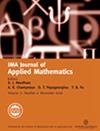Long-time solutions of scalar hyperbolic reaction equations incorporating relaxation and the Arrhenius combustion nonlinearity
IF 1.2
4区 数学
Q2 MATHEMATICS, APPLIED
引用次数: 0
Abstract
We consider an initial-value problem based on a class of scalar nonlinear hyperbolic reaction–diffusion equations of the general form包含松弛和阿伦尼斯燃烧非线性的标量双曲型反应方程的长时间解
我们考虑了一个基于一类标量非线性双曲型反应-扩散方程的初值问题,该方程的一般形式为$$\beargin{align*}&;u_{\tau\tau}+u_{_tau}=u_{xx}}+\varepsilon(F(u)+F(u;0$是一个与松弛时间相关的参数。此外,反应函数$F(u)$由Arrhenius燃烧非线性$$\beagin{align*}&;F(u)=e^{-{e}/{u}}(1-u),\end{align*}$$其中$e>;0$是一个与激活能有关的参数。初始数据由一个简单的阶跃函数给出,对于${x}\le 0$,$u({x},0)=1$,对于${x}>;0美元。上述初值问题模型,在一定的简化假设下,预混气体燃料中的燃烧波;这里,变量$u$表示无量纲温度。根据问题参数$E$和$\varepsilon$的值,确定了初值问题解的大时间结构涉及传播波前的演化,其为反应-扩散或反应-弛豫类型。
本文章由计算机程序翻译,如有差异,请以英文原文为准。
求助全文
约1分钟内获得全文
求助全文
来源期刊
CiteScore
2.30
自引率
8.30%
发文量
32
审稿时长
24 months
期刊介绍:
The IMA Journal of Applied Mathematics is a direct successor of the Journal of the Institute of Mathematics and its Applications which was started in 1965. It is an interdisciplinary journal that publishes research on mathematics arising in the physical sciences and engineering as well as suitable articles in the life sciences, social sciences, and finance. Submissions should address interesting and challenging mathematical problems arising in applications. A good balance between the development of the application(s) and the analysis is expected. Papers that either use established methods to address solved problems or that present analysis in the absence of applications will not be considered.
The journal welcomes submissions in many research areas. Examples are: continuum mechanics materials science and elasticity, including boundary layer theory, combustion, complex flows and soft matter, electrohydrodynamics and magnetohydrodynamics, geophysical flows, granular flows, interfacial and free surface flows, vortex dynamics; elasticity theory; linear and nonlinear wave propagation, nonlinear optics and photonics; inverse problems; applied dynamical systems and nonlinear systems; mathematical physics; stochastic differential equations and stochastic dynamics; network science; industrial applications.

 求助内容:
求助内容: 应助结果提醒方式:
应助结果提醒方式:


